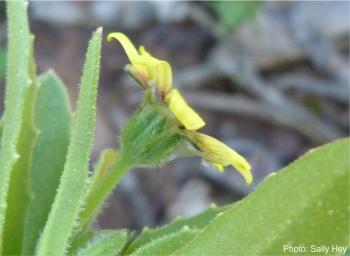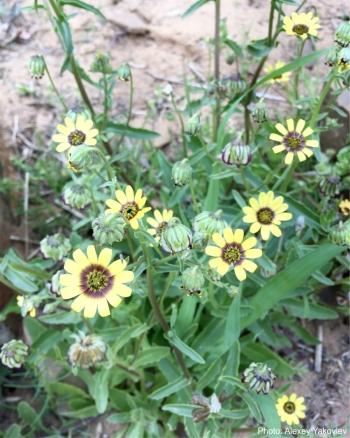Osteospermum monstrosum
Osteospermum monstrosum (Burm.f.) J.C.Manning & Goldblatt (Previous names: Tripteris clandestina Less.; Monoculus monstrosus (Burm.f.) B.Nord.)
Family: Asteraceae
Common names: one-eye monster (Eng.); trekkertjie (Afr.)
Introduction
Osteospermum monstrosum is arguably the commonest Namaqualand spring annual. Most people will have noticed these small plants with yellow flowerheads and inflated, downward-oriented, striped fruiting heads, lining road ditches and disturbed areas in Namaqualand during the springtime

Fig. 1. Osteospermum monstrosum in its natural habitat in Namaqualand (Photo Bengt Oxelman).
Description
Description
This common plant grows rapidly to maturity, and then continues to flower as long as conditions are favourable, but dies off as the summer becomes hotter and drier. It is an annual herb about 200-500 (sometimes as much as 700) mm high, sometimes becoming woody at the base. Plants can be single-stemmed or more branched, and the stems are held upright. The leaves and stems are bright green, quite fleshy, sticky, and aromatic. Leaves are largest at the base of the plant, where they taper as they reach the stem, and become smaller and narrower towards the tops of the stems. At the point where the leaf joins the stem, the leaf wraps slightly around the stem. Leaves are borne at a large angle to the stem. The leaves are quite large, about 20–90 (and rarely up to 130) mm long and 10–20 (rarely up to 30) mm broad, with wavy or toothed margins.

Fig. 2. Osteospermum monstrosum, close-up of flowering and fruiting plant (Photo Desertnaturalist).
The flowerheads are borne at the top of the plant on long, branching flowering stalks with few, small leaves (see Fig. 2). Each flowerhead is surrounded by a row of green, leaflike flowerhead bracts (involucral bracts; see Fig. 3), which have very broad dry translucent margins (most visible in the fruiting head).

Fig. 3. Side view of flowerhead of Osteospermum monstrosum, showing involucral bracts (Photo Sally Hey).
When looking at the flowerheads face-on (see Fig. 4), they are smallish (10–15 mm across) and form a circle, with few spaces between the ray flowers. The ray flowers (outer flowers of the flowerhead, with large petals) are yellow with reddish-maroon/brown centres, and are fairly short, from just a few mm longer than the flowerhead bracts to up to twice the length of the flowerhead bracts (see Fig. 3). The tiny disc flowers in the centre of the flowerhead are black when in bud, yellow when they open (see Fig. 4).

Fig. 4. Face-on view of a flowerhead showing the short yellow ray flowers with their dark maroon bases, and the black central disc flower buds (Photo Kevin Thiele).
Very noticeable for this species are the fruiting heads (see Figs. 1, 2 & 5), many of which are already developing while the plant is still in flower, and are the same size or larger than the flowering heads. The fruiting heads hang downwards from the tips of the flower stalks, and while still developing are silvery-green with distinctive darker stripes formed from the flowerhead bracts and the edges of the developing seeds (technically, fruits). As they mature the seeds develop a striking red-pink tinge on the wings, but are pale brown with transparent wings when ripe (see Figs. 5 & 6). At this point, the flowerhead bracts shrivel up and point back away from the fruits.
It’s worth taking the time for a closer look at the seeds, which are about 9 mm long and consist of a wrinkled, sculptured central section housing the embryo, and three thin, broad, translucent wings (see Fig. 6). At the top of the central section is a round, thin-walled “window” over an internal air cavity. Once mature, the fruits are pale brown and dry, and the wings serve to keep them tumbling in the wind for greater dispersal.
The one-eye monster can be confused with a few other closely-related species that also occur in the Namaqualand region, in particular the dassiepee boneseed, Osteospermum hyoseroides, which shares the very broad transparent margins on the flowerhead bracts, and has very similar fruits, around the same size and with a single “window”. However, O. monstrosum has ray flowers that are only a few mm longer than the flowerhead bracts, or up to twice as long, while O. hyoseroides has ray flowers that are two- to three times the length of the flowerhead bracts, and also usually lack the darker basal ring.
Very similar to O. hyoseroides is the dassie boneseed, O. amplectens, but it is also easily differentiated from O. monstrosum by ray flowers that are two- to three times the length of the flowerhead bracts. Osteospermum amplectens differs from both the previous species by having much smaller fruits, only 4 – 5 mm long, which also do not have any “windows”. In addition, both of these species, with their large attractive flowerheads, usually have ray flowers that are orange rather than yellow, and lack the dark basal ring.
There is one more similar species in this group, Osteospermum breviradiatum. It is, however, rare and not very well known; it has short ray flowers like O. monstrosum, but in other respects, its fruits and its flowerhead bracts are exactly like those of O. amplectens.
Conservation Status
Status
Osteospermum monstrosum is of Least Concern (LC) according to the Red List of South African plants. The one-eye monster is a naturalized weed in parts of Australia (New South Wales, South Australia, Victoria, and in Western Australia (POWO), where it was possibly introduced as an ornamental and has been recorded there since 1851 (Norlindh 1943). The recommended mode of control is hand removal prior to flowering, or spot spraying with glyphosate at 0.5 % before flowering (Florabase). In Australia it is reportedly called stinking Roger (Operation Wildflower), although that name is most often given to a different weedy daisy, Tagetes minuta. The naturalized habitat of the one-eye monster in Australia is in scrub, along roadsides and watercourses and on disturbed ground, mainly on sandy soils (eFlora SA).

Fig. 5: A large Osteospermum monstrosum plant growing in favourable conditions (Photo Alexey Yakovlev).
Distribution and habitat
Distribution description
The natural distribution of Osteospermum monstrosum is in the Succulent Karoo and Desert Biomes, with a few collections from southern Angola and southern Namibia (SANBI NewPOSA). It is widespread in disturbed habitats, including roadsides and as a weed of cultivated lands across Namaqualand south to Cape Town, and eastwards to Bredasdorp and the Little Karoo.
Derivation of name and historical aspects
History
Formerly, this species was removed from Osteospermum and placed in the genus Tripteris (tri- for ‘three’ and pteris for ‘wings’). Subsequently, Nordenstam (2006) placed it in the genus Monoculus (mono meaning ‘one’ and oculus ‘eye’, for the single “window” between one of the upper pairs of wings). At present however it is back in the genus Osteospermum, whose name is derived from the Greek osteon, meaning ‘bone’ and spermum, ‘seed’, referring to the very hard seed coat of many members. The English common name one-eye monster is derived from Monoculus monstrosum. The Afrikaans trekkertjie relates to it being either a ‘little puller’ or a ‘little traveller’, perhaps referring to the weedy habit along water- and roadways.
Osteospermum is a large genus with around 80 species, in the daisy tribe Calenduleae. The Mediterranean-centred genus Calendula, with many herbal, medicinal, cultural, horticultural and culinary uses, is a close relative, while the other genera (Dimorphotheca and Garuleum) occur only in southern Africa.

Fig. 6. Fruiting head of Osteospermum monstrosum showing ripe, brown fruits and dry, shrivelled involucral bracts oriented backwards away from the fruits. Each individual fruit has three broad wings and a central section with a thin-walled translucent “window” at the top end (Photo Kevin Thiele).
Ecology
Ecology
The one-eye monster germinates, grows and flowers during the short succulent karoo spring period, when it is one of the most ubiquitous plants in the region. The short ray flowers make the flowerheads far less conspicuous than other closely-related species of Osteospermum, and there is speculation that it may self-pollinate. It rapidly develops fruits which have three large wings, which will facilitate dispersal to new sites. The hot dry summers kill off the previous generation of adult plants, but the seeds survive to germinate in the following spring.
Uses
Use
There are no documented cultural uses for the one-eye monster, but it is well-known in its naturalised range in Australia. Despite its propensity for weediness, seeds of Osteospermum monstrosum, together with cultivation instructions, appear to be available from commercial seed sellers in South Africa and globally.
Growing Osteospermum monstrosum
Grow
The one-eye monster is not recommended as a horticultural species, since it is weedy and has shown the ability to colonise new areas (e.g. in Australia). Although the appearance of the whole plant can be unattractive, the fresh flowerheads and the fruiting heads are striking and interesting (see Fig. 5).
References
- Desertnaturalist. 2021. Observation of Osteospermum monstrosum, Cape Peninsula. iNaturalist. Online. https://www.inaturalist.org/observations/120355620.
- eFlora SA, Electronic Flora of South Australia Fact Sheet, Osteospermum clandestinum. State Herbarium of South Australia. http://flora.sa.gov.au/cgi-bin/speciesfacts_display.cgi?form=speciesfacts&name=Osteospermum_clandestinum. Accessed 12/06/2022.
- Florabase. Monoculus monstrosus (Burm. f.) B. Nord. https://florabase.dpaw.wa.gov.au/browse/profile/29418. Accessed 12/06/2022.
- Hey, S. 2021. Observation of Osteospermum monstrosum, Hawerland Farm, West Coast. iNaturalist. Online. https://www.inaturalist.org/observations/98296800.
- Latti, I. n.d. Osteospermum monstrosum. Operation Wildflower. Online. https://www.operationwildflower.org.za/index.php/component/joomgallery/herbs/osteospermum-clandestinum-was-tripteris-clandestina-il-2-3087?Itemid=8. Accessed 12/06/2022.
- Nordenstam, B. 2006. Generic revisions in the tribe Calenduleae (Compositae). Compositae Newsletter 44: 38-49.
- Norlindh, T. 1943. Studies in the Calenduleae I: Monograph of the genera Dimorphotheca, Castalis, Osteospermum, Gibbaria and Chrysanthemoides. C.W.K. Gleerup, Lund.
- Oxelman, B. 2016. Observation of Osteospermum monstrosum, Saldanha. iNaturalist. Online. https://www.inaturalist.org/observations/91452708.
- POWO, Plants of the World online. Osteospermum monstrosum. https://powo.science.kew.org/taxon/urn:lsid:ipni.org:names:77132420-1. Accessed 12/06/2022.
- Raimondo, D., Von Staden, L., Foden, W., Victor, J.E., Helme, N.A., Turner, R.C., Kamundi, D.A. & Manyama, P.A. (eds) 2009. Red list of South African plants. Strelitzia 25. South African National Biodiversity Institute, Pretoria.
- SANBI NewPOSA 2022. Botanical Database of Southern Africa (BODATSA). Accessed via http://newposa.sanbi.org/sanbi/Explore. Searched 12/06/22.
- Thiele, K. 2006. Monoculus monstrosus. Flickr. Online. https://www.flickr.com/photos/66951228@N07/6282959374/ & https://www.flickr.com/photos/66951228@N07/6282445735.jpg.
- Yakovlev, A. 2017. Observation of Osteospermum monstrosum, Groot Winterhoek, Cederberg. iNaturalist. Online. https://www.inaturalist.org/observations/119050260.
Credits
Nicola Bergh
Compton Herbarium, Foundational Research & Services
July 2022
Acknowledgements: the author thanks Bengt Oxelman, Desertnaturalist, Sally Hey, Kevin Thiele and Alexey Yakovlev for making their images available via iNaturalist or Flickr.
Plant Attributes:
Plant Type: Bi/Annual
SA Distribution: Northern Cape, Western Cape
Soil type: Sandy, Loam
Flowering season: Spring, Early Summer
PH:
Flower colour: Brown, Yellow
Aspect: Full Sun
Gardening skill: Easy
Special Features:
Horticultural zones








Rate this article
Article well written and informative
Rate this plant
Is this an interesting plant?
Login to add your Comment
Back to topNot registered yet? Click here to register.